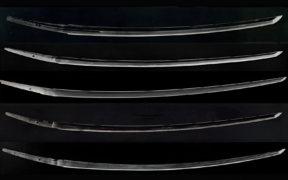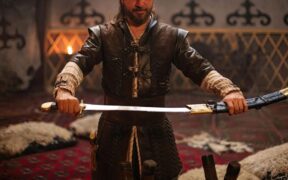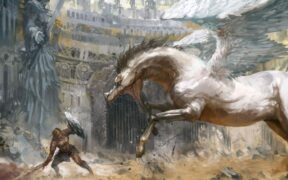Our content features commercial links to our products, committed to transparent, unbiased, and informed editorial recommendations. Learn More
15 Most Expensive Swords and Daggers in History
NO AI USED This Article has been written and edited by our team with no help of the AI
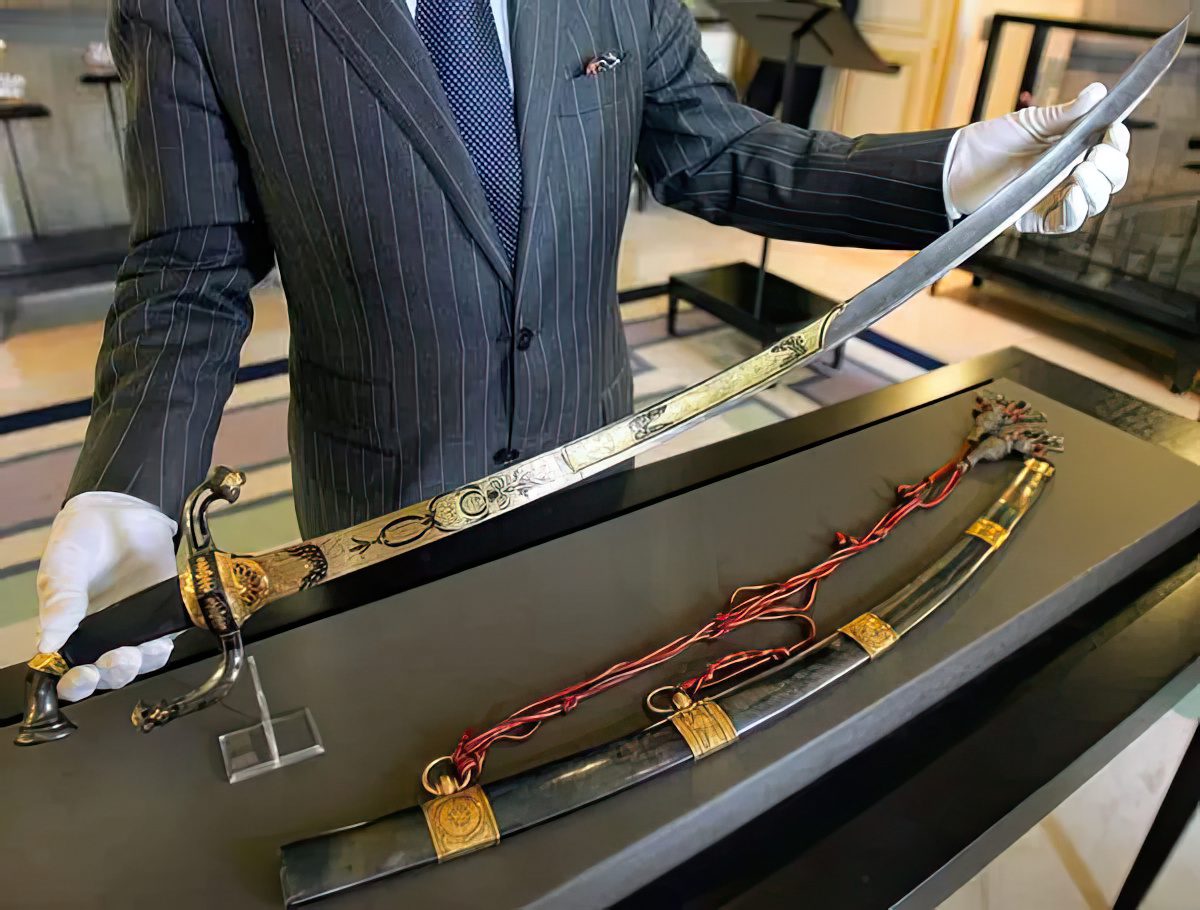
Swords have been a hallmark of the greatest warriors and even became as famous as their owners. Many of them are extremely valuable because of their historical significance and craftsmanship. Some daggers are also considered works of art where avid collectors purchased them for hundreds and millions of dollars.
In this article, we’ve rounded up the most expensive swords and daggers in history and the stories behind them.
1. Tipu Sultan’s Bedchamber Sword – $17.3 million
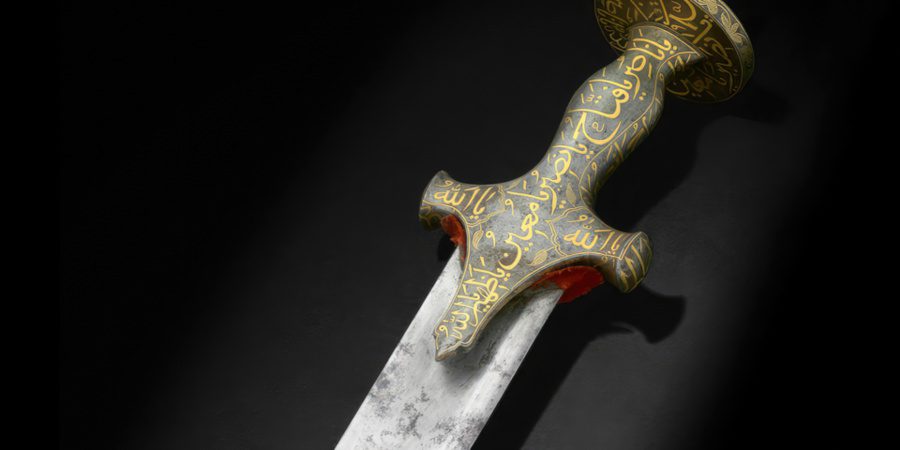
Near the end of May 2023, Tipu Sultan’s fabled bedchamber sword was sold at an astounding $17.3 million or £14 million at the Bonhams Islamic and Indian Art Sale in London. Among all the greatest weapons of Tipu Sultan’s still in private hands, this sword is said to be the greatest of them all.
After Tipu Sultan’s stronghold at Seringapatam fell on 4th May 1799, this sword was one of the many weapons removed from his private quarters in his palace. Due to being in constant alert against attack, Tipu Sultan slept in a hammock suspended from the ceiling of his bedchamber with a pair of pistols and this sword by his side.
The blade of this sword has the inscription “The Sword of the Ruler” and was manufactured by Mughal swordsmiths that modeled it after the German blades that were introduced to India in the 16th century. Featuring a hilt that is inlaid with gold calligraphy, this sword of the Tiger of Mysore is unquestionably exquisite.
2. 18th Century Boateng Saber – $7.7 million
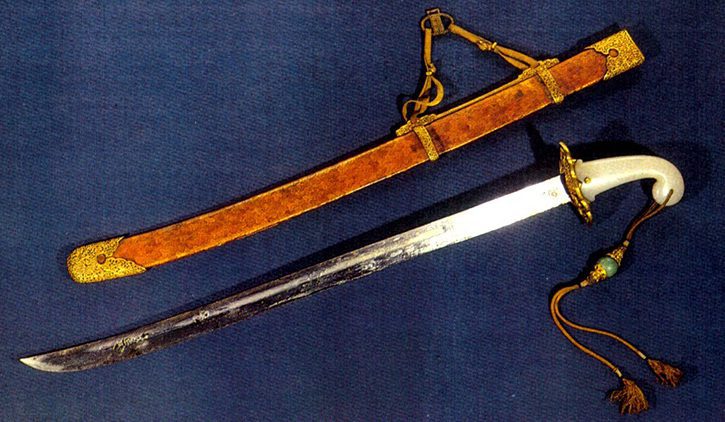
The 18th century Boateng saber remains the second most expensive sword in the world. Sold in auction twice, originally for $5.93 million in 2006 and for $7.7 million in 2008, it features decorations and inscriptions alluding to the Chinese emperor Qianlong of the Qing dynasty.
The Boateng saber has a blade inscribed with “Bao Teng”, meaning Soaring Precious. It also has a white jade handle stylized with decorative leaves and a steel blade decorated with copper, silver, and gold.
The Chinese saber has a single-edged and slightly curved blade, ideal for slashing. It was made during the reign of Qianlong (1735 – 1796). With its deadly practicality and craftsmanship, the Boateng saber is worthy of a powerful ruler.
3. Napoleon Bonaparte’s Gold-Encrusted Sword – $6.4 million
Napoleon Bonaparte, the first emperor of France, owned a gold-encrusted sword that was auctioned off for more than $6.4 million. The sword has a curved blade inspired by Mameluke’s swords during his Egyptian campaign. Its 32-inch blade features intricate designs in gold while being strong enough for battle.
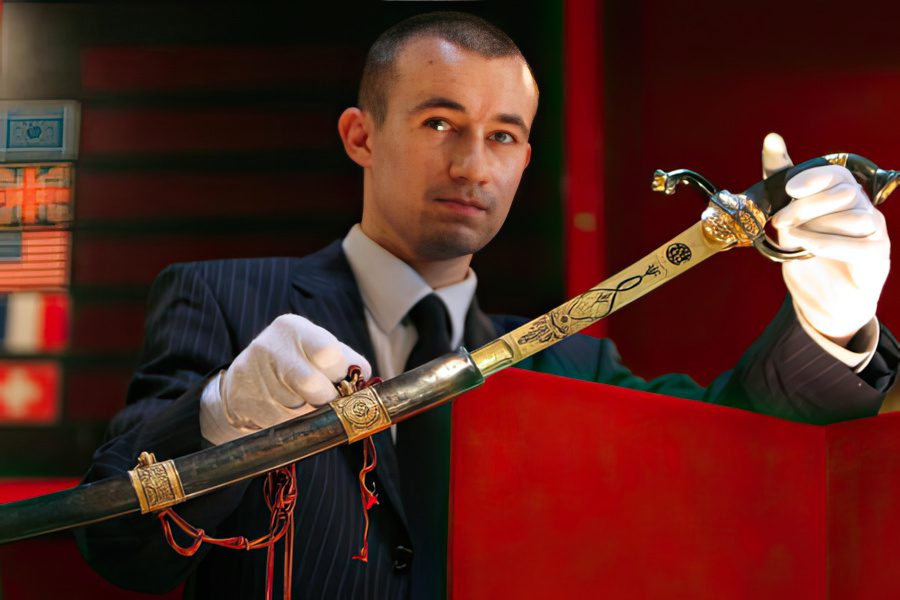
In 1800, Napoleon, who was not yet emperor at the time, carried the sword in the Battle of Marengo, where he drove the Austrian army from much of Italy. His victory in the battle also consolidated his power in France, making the sword even more valuable. Napoleon Bonaparte became the crowned emperor in 1804.
Years later, Napoleon gifted the sword to his brother as a wedding present and it was passed down through generations. The direct descendants of the French emperor owned the sword, including Prince Victor Napoleon. However, the disagreement within the Bonaparte family resulted in it being auctioned off.
The conditions of the auction allowed the sword to be sold to a foreign buyer, but the buyer must have an address in France and keep it in the country for about five to six months each year. In 1978, the French government declared the sword a national treasure.
Napoleon Bonaparte is one of the greatest emperors and military generals in history. So, it’s not surprising that his sword is also considered a work of art and a piece of Napoleonic history.
4. 15th-Century Nasrid Period Ear-Dagger – $5.9 million
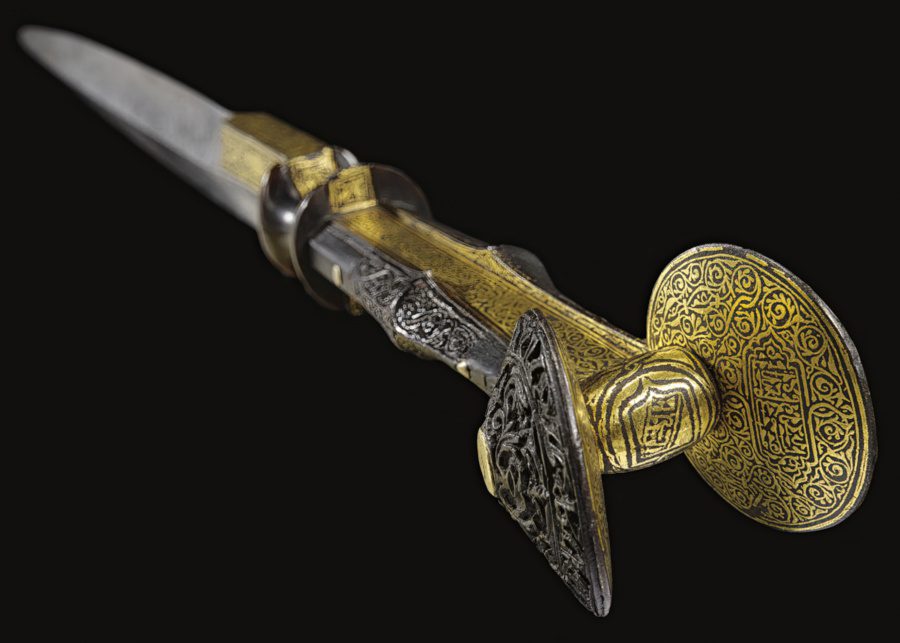
Recognized for its large circular ears, the Nasrid period ear-dagger from Spain had a price tag of about $5.9 million. The Nasrids were the last Muslim dynasty in Spain and ruled Granada from 1238 to 1492 until the Christian conquest of Granada finally ended their rule. Some believe the dagger was a pseudo-Arab regalia made after the fall of the last Muslim Kingdom of Spain.
The Nasrid period ear-dagger has Arabic and Latin inscriptions on the ears and hunting scenes depicted in a gold overlay on the blade and grip. Its forte features a figure armed with a crossbow chasing animals, including a lion. This is likely a metaphor for Castile-Leon, which became the predominant Christian kingdom in Spain, having a significant part in the conquest of the Muslim south.
Ear daggers likely originated from North Africa before being widely used in Spain during the 15th and 16th centuries. They were once fashionable among nobles and a portrait of a young Edward VI features a similar dagger on his waist. The ear dagger is also known as alla Levantina in Italian and dague à oreilles in French.
5. Shah Jahan’s Kard Dagger – $3.3 million
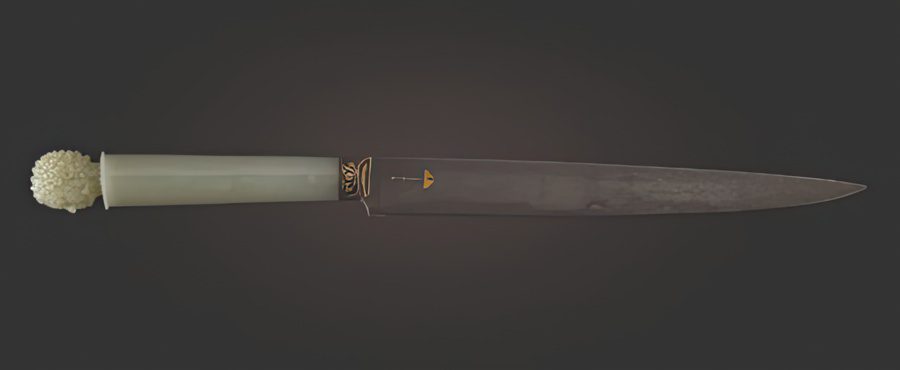
The jade-hilted kard dagger of Mughal emperor Shah Jahan was sold for more than $3.3 million. One of the masterpieces of Mughal art, the kard dagger had a straight, single-edged blade worn on the left side of the belt. Many believe that it was either created by the European lapidaries at the Mughal court or influenced by their works.
In one Mughal painting, Prince Khurram, the future Shah Jahan, is portrayed wearing a kard dagger with a carved human head pommel in his waistband. Some believe the head-shaped design was derived from depictions of cherubs as seen in many Mughal paintings. Others suggest it was a typical depiction of a young European man or Christ as the Good Shepherd.
The blade features the inscription, sahib qiran thani, meaning Second Lord of the Auspicious Conjunction, a title of Shah Jahan. However, the lack of further titles suggests that it functioned as a personal dagger. It also has an Indian chhatri motif associated with divinity or royalty.
6. The Gem of the Orient Knife – $2.1 million
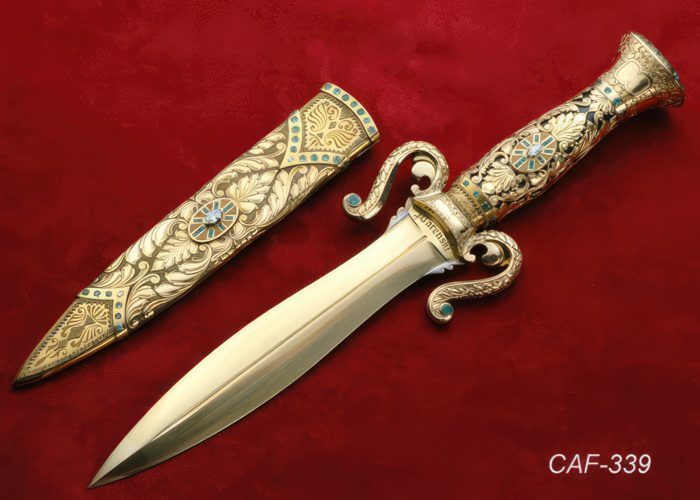
The Gem of the Orient knife was designed by American custom knife-maker Buster Warenski in 1966. The lavish knife had 9 diamonds and 153 emeralds on the handle. An additional 32 oz. of 18k gold was also used for both the handle and blade. It was featured on the cover of Blade Magazine for August 1991.
Buster Warenski’s Gem Of The Orient is considered the highest quality in the art knife world due to its craftsmanship, creativity, originality, and exquisite design. It is believed to be a $1.5 million knife, though some sources state that it was initially sold for $1.2 million and later resold for $2.1 million.
7. Shah Jahan’s Sardonyx Khanjar – $2 million
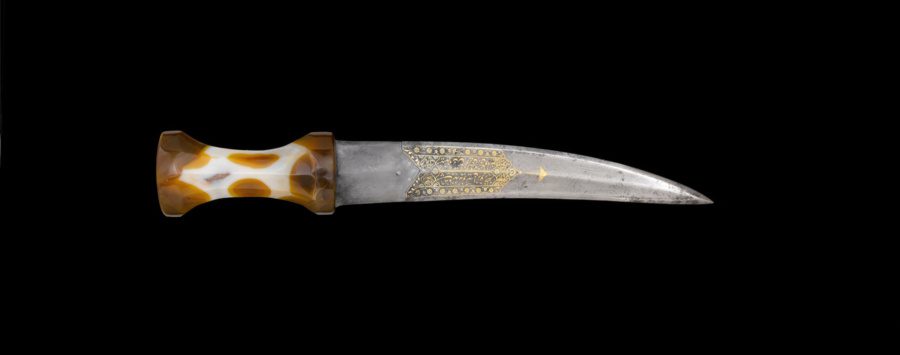
The sardonyx khanjar, dating from around 1629 to 1630, seems to be the second most well-known dagger of the Mughal emperor Shah Jahan. Most recognized for its sardonyx hilt, the khanjar features a double-edged, curved blade with inscriptions. It was sold for over $2 million at Bonhams auction house.
A patron of fine arts, Shah Jahan’s dagger proved that the Mughal artistic achievements reached their zenith under his rule. He owned several bladed weapons that were not only for warfare, but also works of art, usually decorated with precious metals and stones.
The khanjar features detailed inscriptions such as his name, title, and date and place of manufacture. It was made in Akbarabad during his 2nd regnal year 1039. Also, the inscription describes him as the conqueror of the world and the defender of religion.
8. Ceremonial Sword of the Nizam of Hyderabad – $1.9 million
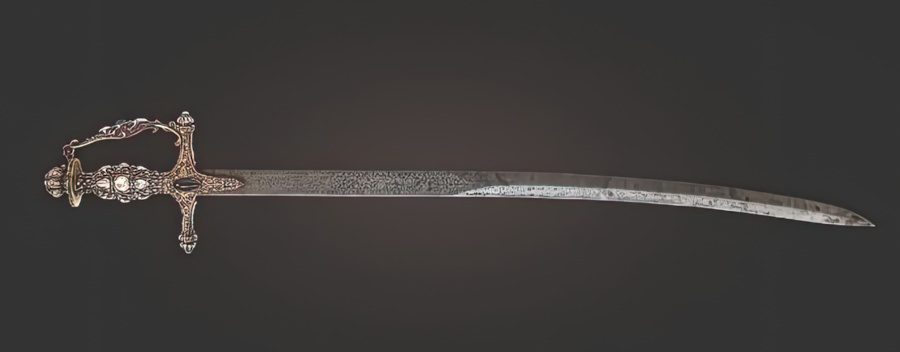
A ceremonial sword that belonged to the Nizam of Hyderabad was set with diamonds, emeralds, and rubies and sold for over $1.9 million. The Nizams ruled over the Indian state of Hyderabad from 1724 to 1948. Ceremonial swords represented their military prowess and power during royal processions.
The ceremonial sword has an inscribed steel blade, a gold hilt, silver mounting, and its design is typical of South India, where ornate swords were widespread in the late 19th century.
9. Ulysses S. Grant’s Civil War Presentation Sword – $1.6 million

During the American Civil War, General Ulysses S. Grant became the symbol of the Union’s victory against the Confederacy. He later became the 18th President of the United States from 1869 to 1877. The Kentucky citizens gave the presentation sword to the future president when he took the position of General in Chief of the United States Army in 1864.
The gold-and-silver presentation sword features 26 mine-cut diamonds, spelling out the initials U.S.G., set upon a large amethyst. It also has a silver grip in the form of the goddess Victory and an American eagle over her head. Its 33-inch blade featured engraved battle scenes, from cavalry engagements to artillery firing and infantry forces. It was sold for $1.6 million in 2007.
10. Qianlong Imperial Hunting Knife – $ 1.2 million
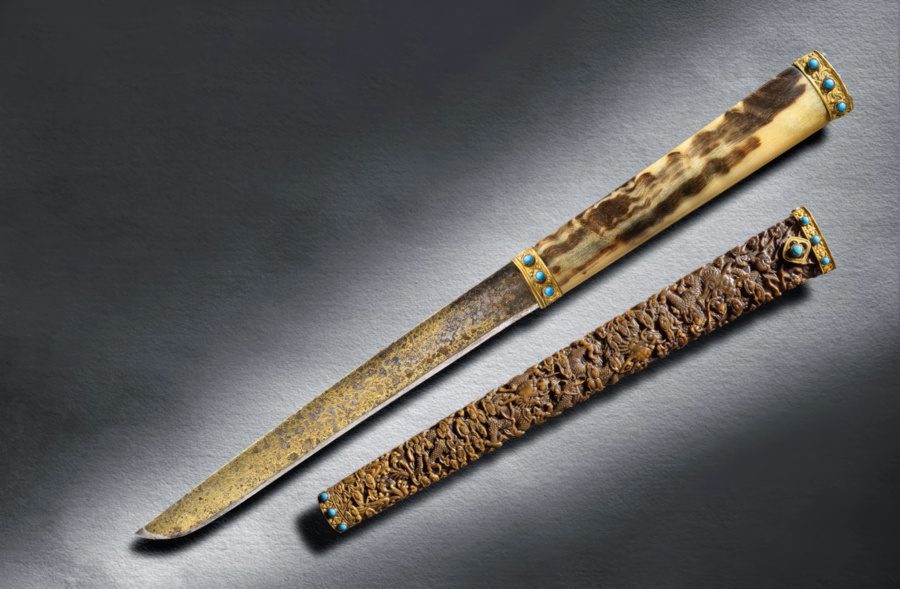
The imperial hunting knife features a steel blade with a Qianlong reign mark on the spine. In the painting Taking a Stag with a Mighty Arrow, the Qianlong emperor is portrayed wearing a similar knife on his belt while hunting. This Qianlong imperial hunting knife was sold for around $1.2 million at Sotheby’s.
Knives of this type served as hunting weapons, but eventually became part of the Manchu ceremonial attire. In Manchu tradition, knives had symbolic importance and Manchu men traditionally carried knives and cut their meats themselves. Knives also became part of the dowries of princesses. Also, women cut their meat when eating sacrificial pork.
It has an antelope horn hilt and rhinoceros horn scabbard, both decorated with turquoise cabochons. The scabbard features carvings of dragons among the clouds, rough waves crashing on rocks, leaves, and florets. Its exceptional craftsmanship suggests that it was created in the Palace Workshop, where hunting and military weapons were manufactured for the emperor and his family.
11. 18th-Century Jade-Hilted Dagger – $915,000
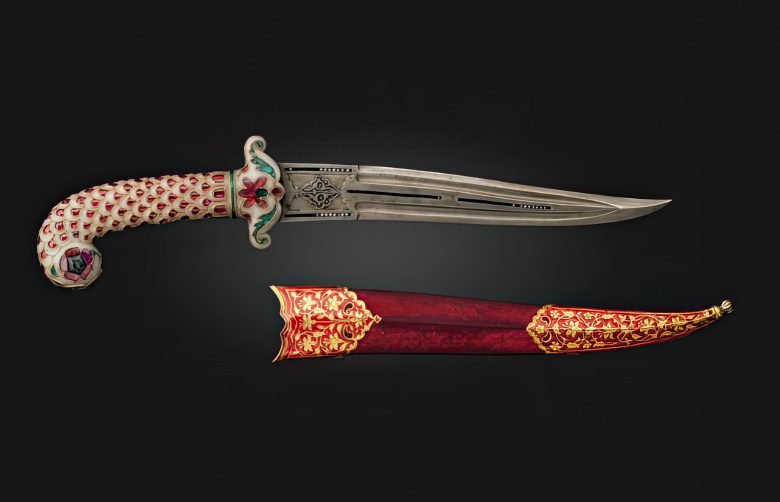
The North Indian or Deccan dagger, originating from around 1700 to 1725, features rubies and emeralds set on a jade hilt. Its steel blade features channels with free-running seed pearls which are related to the Ottoman and Iranian examples from the 16th and 17th centuries. They were dubbed as the tears of the wounded or the tears of Allah. Also, the jade-hilted dagger has a velvet-covered scabbard with a gold locket and chape.
12. Shah Jahan’s Indian Talwar – $717,800
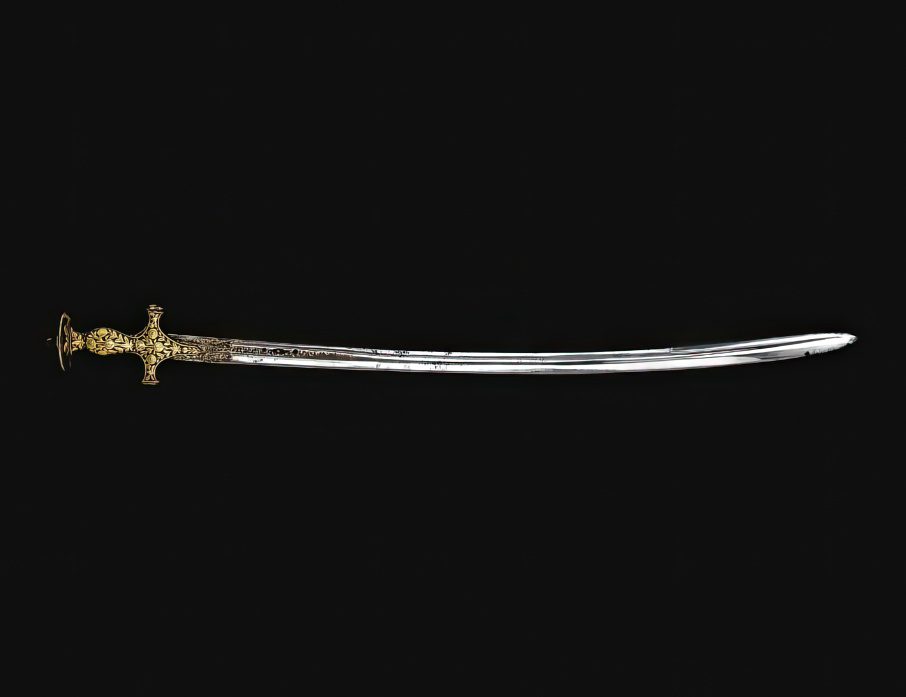
A fine 17th-century Indian talwar served as the sword of the Mughal emperor Shah Jahan. It was among the courtly items reserved for the personal use of an emperor. In 2007, Sotheby’s sold it for 446,100 GBP, about $717,800. It has a slightly curved blade, inlaid gold inscriptions and decorations, and a disc pommel. It also features the chattra motif and is decorated with lotuses and poppies.
13. Admiral Nelson’s French Officer’s Sword – $521,800
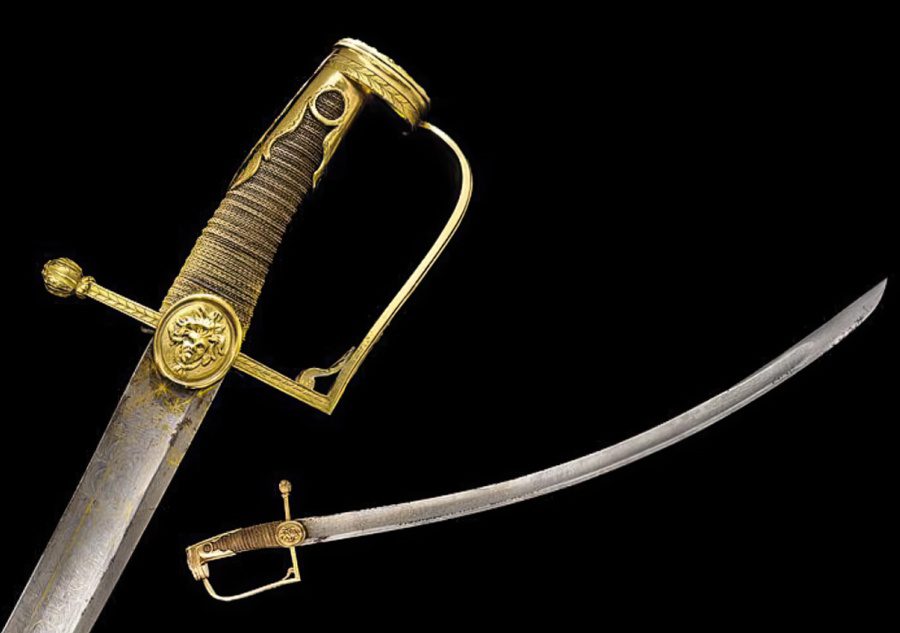
The First Empire Officer’s Sword belonging to British naval commander Horatio Nelson was sold for $521,800 at Sotheby’s auction house in London. He is among the greatest naval heroes, so his sword also gained historic importance.
Nelson is renowned for his naval victories against the French during the Napoleonic Wars. The admiral defeated a Franco-Spanish fleet at the Battle of Trafalgar, but a sniper killed him on his British ship, Victory.
Admiral Nelson had bequeathed the sword to his financial adviser Alexander Davison. It was undiscovered for two centuries until Davison’s descendant invited a Sotheby’s expert to view some of the admiral’s possessions.
14. The Chief Legaic War Dagger – $482,000
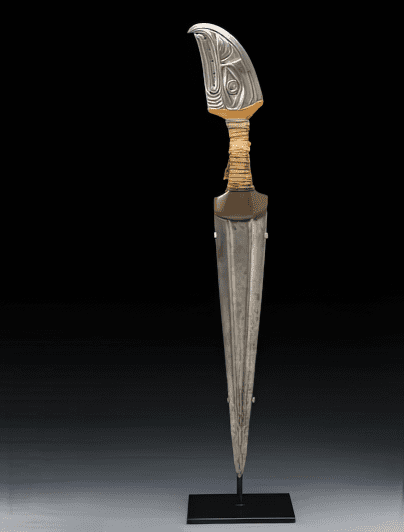
The war dagger of Chief Legaic was sold for $482,000. Legaic was the highest-ranking chief of the Gispaxloats tribe in British Columbia, Canada. However, the name Legaic was a chiefly title passed down through generations. Every man of First Nations carried daggers which served as status symbols. Such objects also gained cultural and historical significance.
The war dagger has the traditional name Eagle at the head of the Skeena River and was handed down within the clan from one generation to another. It features an eagle-head pommel with an abalone shell inlay on the eye and a double-edged blade, making it a formidable combat weapon.
15. 13th-Century Kamakura Katana – $418,000
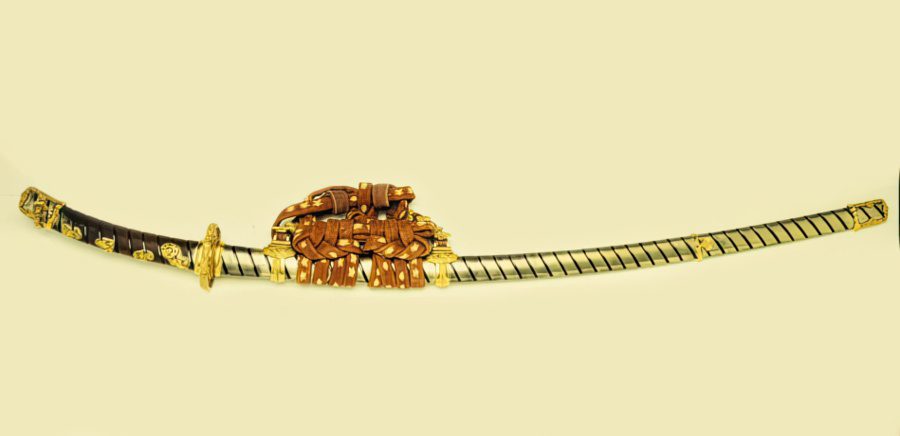
The Japanese katana sword was the weapon most associated with the samurai of feudal Japan. It has a curved, single-edged blade, admired for its craftsmanship and artistic qualities. The most expensive katana sold for $418,000 and was produced during the Kamakura period.
The 13th-century katana was part of the collection of Dr. Walter Ames Compton who collected Japanese swords for 50 years. Although most buyers of expensive samurai swords were Japanese, an unidentified European collector bought the katana sword.
Conclusion
While swords don’t have much use in modern times, except for in martial arts and as a ceremonial item in the military, they have not lost their importance among art and antique collectors. Their historical significance, quality, and craftsmanship contribute to their value. It is no wonder that swords and daggers were among the most expensive items sold at auctions as many are willing to pay a hefty price tag to get their hands on them.
